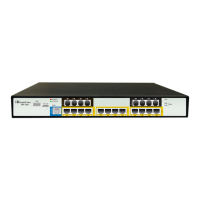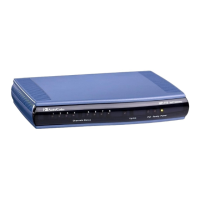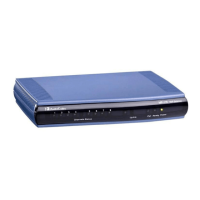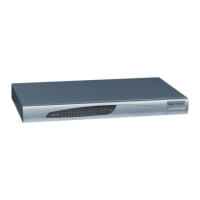Version 5.8 95 October 2009
SIP User's Manual 3. Web-Based Management
b. Queue Policy: Similar to Tx traffic, Rx traffic queueing can be based on a
shaping class or on strict priority (unless unlimited bandwidth is selected). By
default, however, the queue policy is set to Policer, which is a relatively simple
method of bandwidth control. With the Policer option, you can dedicate a portion
of the bandwidth to a certain traffic type. This portion always remains available to
its traffic type, even when not in use. This is a simpler method, as priority is not
used at all. When selecting a class-based queue policy, you must define an Rx
Traffic Policy Class, which is identical to defining a Tx Traffic Shaping Class,
described earlier. However if you select the Policer as your queue policy, defining
a policing class is even simpler, as it lacks the priority setup.
c. Click the New Entry link; the following page appears:
Figure 3-75: Adding Rx Shaping Class
d. In the 'Name' field, enter a name for the new class (e.g., Class B) and then click
OK to save the settings; you are returned to the previous page.
e. Click the newly added class name; the following page appears:
Figure 3-76: Dfining Rx Shaping Class
f. Configure the following fields:
a. Name: name of the class.
b. Bandwidth: reserved reception bandwidth in kilobits per second. You can
limit the maximum allowed bandwidth by selecting the 'Specify' option and
then define the Kbits/s.
c. Schedule: by default, the class is always active. However, you can configure
schedular rules to define time segments during which the class may be
active.
3.4.3.4.4 Configuring DSCP Settings
The DSCP Settings item defines Differentiated Services Code Point (DSCP). Differentiated
Services (Diffserv) is a Class of Service (CoS) model that enhances best-effort Internet
services by differentiating traffic by users, service requirements and other criteria. Packets
are specifically marked, allowing network nodes to provide different levels of service, as
appropriate for voice calls, video playback or other delay-sensitive applications, via priority
queuing or bandwidth allocation, or by choosing dedicated routes for specific traffic flows.
Diffserv defines a field in IP packet headers referred to as DSCP. Hosts or routers passing
traffic to a Diffserv-enabled networks typically mark each transmitted packet with an
appropriate DSCP. The DSCP markings are used by Diffserv network routers to
appropriately classify packets and to apply particular queue handling or scheduling
behavior.

